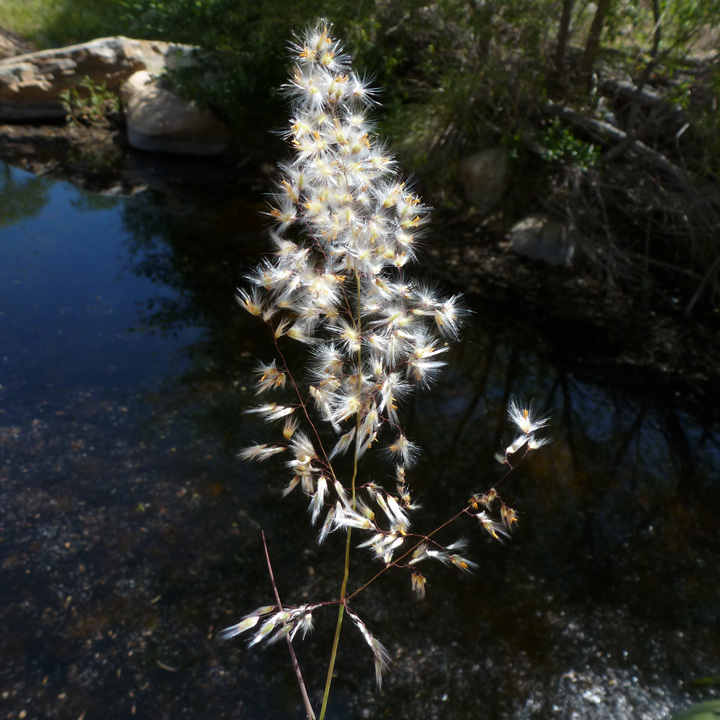Search
Melinis repens
|
|
|
|
Family: Poaceae
rose Natal grass
[Rhynchelytrum repens (Willd.) C.E. Hubbard, moreRhynchelytrum roseum (Nees) Stapf & C.E. Hubbard ex Bews, Saccharum repens Willd., Tricholaena repens (Willd.) Hitchc., Tricholaena rosea Nees] |
Plants annuals or short-lived perennials. Culms (20)40-150 cm, decumbent, usually rooting at the lower nodes; nodes pubescent; internodes glabrous or with papillose-based hairs, hairs to 4.7 mm. Sheaths glabrous or with papillose-based hairs, hairs 0.5-4.7 mm; ligules of hairs, 0.7-2.2 mm; blades 3.6-27 cm long, 2-9(14) mm wide, flat, glabrous or pubescent, with or without papillose-based hairs. Panicles (4)6-22 cm long, (1.5)2.5-12 cm wide; primary branches to 11 cm, ends of the primary branches, secondary branches, and pedicels capillary; pedicels 0.6-5.3 mm, usually hairy distally, hairs to 6.3 mm. Spikelets 2-5.7 mm; calluses hairy, hairs to 4 mm. Lower glumes 0-1.7 mm, pubescent, sometimes with papillose-based hairs, apices rounded, truncate, or slightly cleft; upper glumes (1.9)2.3-4.9 mm, enclosing the upper florets, gibbous basally, densely pubescent, hairs to 7 mm, sometimes papillose-based, varying from white to rose or darkish purple, apices tapering, beaked, glabrous, unawned or awned, awns to 4.1 mm; lower florets staminate or sterile; lower lemmas 1.9-4.8 mm, unawned or with awns to 4.2 mm; lower paleas 0.9-4 mm; anthers (0.8)1.5-2.6 mm, orange-brown to orange; upper lemmas 1.8-2.7 mm, glabrous; anthers 3, 1.2-1.7 mm, orange-brown to orange. Caryopses 1.3-1.9 mm long, 0.6-0.9 mm wide. 2n = 36. Melinis repens is probably native to Africa and western Asia. It is now established throughout the subtropics, including the southern portion of the Flora region. It has been grown as an ornamental, but it is now established and often weedy in warmer portions of the region. Plants in the Flora region belong to Melinis repens (Willd.) Zizka subsp. repens, one of four weakly-separated subspecies. FNA 2003, Gould 1980 Common Name: rose Natal grass Duration: Annual Nativity: Non-Native Lifeform: Graminoid General: Annual or short lived perennial grass; stems 40-150 cm, decumbent to erect with geniculate bases, rooting at lower nodes; nodes pubescent; internodes glabrous or with papillose-based hairs to 5 mm. Vegetative: Sheaths glabrous or with papillose-based hairs 0.5-5 mm; blades 3-27 cm long, 2-9 mm wide, flat, glabrous or pubescent; ligules of hairs, 1-2 mm long. Inflorescence: Panicles 6-22 cm long, 2.5-12 cm wide; primary branches to 11 cm; pedicels, secondary branches, and ends of primary branches are capillary; pedicels to 6 mm, usually hairy near the end, the hairs up to 6 mm long; spikelets 2-6 mm, 2-flowered, with hairy calluses; lower glumes tiny, pubescent, with rounded apices; upper glumes 2.5-5 mm, enclosing upper florets, densely pubescent with hairs to 7 mm, varying from white to rose or darkish purple, unawned or with awns to 4 mm; lower florets sterile, the lemmas unawned or with awns to 4 mm; upper florets bisexual, the lemmas 2 mm, unawned, glabrous. Ecology: Found on rocky slopes and in moist canyon bottoms from 2,500-4,500 ft (762-1372 m); flowers July-November. Distribution: Native to Africa and West Asia; Introduced to subtropical regions worldwide; in the southern US, from CA east to NC; south through the Greater Antilles, MEX, into S. Amer.; also in Europe, Asia and Australia. Notes: This attractive exotic grass is like no other, with its open, drooping pink-silvery inflorescence which glimmers in the sun. This species has naturalized in the southwest after being seeded for range improvement. Ethnobotany: Valued as livestock fodder in Africa; used in making banana beer in Tanganyika. Etymology: Melinis comes from Greek mel for honey, the genus are also known as molasses grass, while repens means having rooting or creeping stems. Synonyms: Rhynchelytrum repens, R. roseum, Saccharum repens, Tricholaena repens, T. rosea Editor: SBuckley 2010, FSCoburn 2015, AHazelton 2015 |


